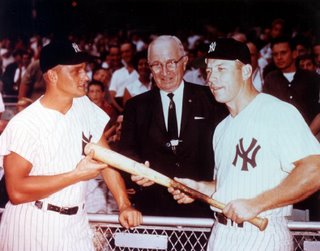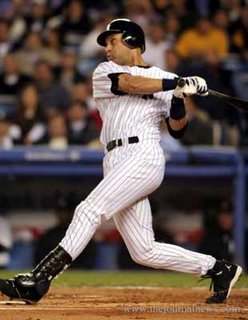 I was prompted to write this piece after an exchange at Bronx Banter regarding Derek Jeter's 9th inning sacrifice bunt with Johnny Damon on 2nd and no one out. The game was 5-4 Yankees and Mariano had induced a double play to end the 8th.
I was prompted to write this piece after an exchange at Bronx Banter regarding Derek Jeter's 9th inning sacrifice bunt with Johnny Damon on 2nd and no one out. The game was 5-4 Yankees and Mariano had induced a double play to end the 8th.
Some would argue that a sac bunt is a wasted out, and that outs are too precious to give up. They would argue that small ball is essentially a way to lose ballgames: see Earl Weaver. Others, still, would argue that a career .315 hitter like Jeter has just as good a chance at poking a ball to the right side swinging away and driving in the run without the sacrifice. Why give up an out?
I would wholeheartedly agree with that notion in an earlier situation. I don't see the point in employing that strategy in the early point of a ballgame, and I think we'd all be insane to think that a ballclub made up of power hitting All Stars should lower themselves to scratching out a run here and there. It would be a waste of talent and potential run production. I would remind those critics of the sacrifice bunt that managers for more than 100 years have recognized the value of a well placed sacrifice in a late inning situation when insurance is all you need to put a game to bed. Even Mickey Mantle was known to give up his at bat in certain situations to get the extra run late. His teams were fairly successful if I recall. In the loss we suffered against Minnesota, the error was not Jeter's sacrfice, but the inability of the batters behind him to score the run one way or the other. In general, the only way one can fail with a runner on third and less than 2 outs, is to strike out, pop up, or ground out sharply to third base. Anything else will get you that run. If the runner is on second, you need a hit to score him and nothing short of a hit.
Even Mickey Mantle was known to give up his at bat in certain situations to get the extra run late. His teams were fairly successful if I recall. In the loss we suffered against Minnesota, the error was not Jeter's sacrfice, but the inability of the batters behind him to score the run one way or the other. In general, the only way one can fail with a runner on third and less than 2 outs, is to strike out, pop up, or ground out sharply to third base. Anything else will get you that run. If the runner is on second, you need a hit to score him and nothing short of a hit.
The situation was right for a sac bunt. Jeter handles the bat very well. Damon can run. Sheffield rarely strikes out, and more often than not gets good wood on the ball. Should he somehow fail, A-Rod was the 2005 AL MVP and has a career BPS (avg. + .slg) of about .835 with runners in scoring position. Sheffield's is about .820, compared to Jeter's .709 BPS with RISP. For context, Barry Bonds puts up a .865, Hank Aaron a .864, Willie Mays a .839, and Mickey Mantle a .811. It's not to say that Jeter, with a 3 for 3 night and 3 RBI's, wouldn't have driven Damon home from 2nd forgoing the bunt, but with Mariano Rivera on the mound and a chance to give him an extra cushion, most managers would have made the same choice. Even some of the harshest critics of the Yankees proposed "small ball" approach admit that it was the right thing to do. Look at this highly critical article from Phil Allard of WCBS from early in Spring Training, and tell me the 4th paragraph doesn't apply in some way to what we saw against Minnesota.
It's not to say that Jeter, with a 3 for 3 night and 3 RBI's, wouldn't have driven Damon home from 2nd forgoing the bunt, but with Mariano Rivera on the mound and a chance to give him an extra cushion, most managers would have made the same choice. Even some of the harshest critics of the Yankees proposed "small ball" approach admit that it was the right thing to do. Look at this highly critical article from Phil Allard of WCBS from early in Spring Training, and tell me the 4th paragraph doesn't apply in some way to what we saw against Minnesota.
If you go by Sabermetrics, there is an argument to be made. A runner on second with nobody out has a 63% chance of scoring. A runner on third with 1 out has a 66% chance. In the former situation a team will score an average of 1.19 runs, and the latter situation yields .983 runs after the bunt. Statistically, it appears as though neither strategy yields a clear and decisive outcome. In the first 7 or 8 innings of a ballgame, I think I'd take my chances and swing away. The additional .3 runs that the stats bear out are worth the risk. In the 9th inning, up a run, with Mariano Rivera on the mound, I will 100% support the sacrifice as a strong option. I only want one run, and my chances of getting that run increase by 3%. I'll take it. If you read the article I linked to in the 2nd paragraph, you'll see that even Sabermetrics experts fail to completely agree on sacrifice bunting and its value, or lack thereof. Bill James is generally considered one of the fathers of metrics in baseball and he seems to be more open to a situational sacrifice than others. If you scroll down at this link to the situational bunting charts, you'll see that the situation the Yankees were faced with last night was one of the few times that sac bunting is a decent proposition at +0.1%.
If you read the article I linked to in the 2nd paragraph, you'll see that even Sabermetrics experts fail to completely agree on sacrifice bunting and its value, or lack thereof. Bill James is generally considered one of the fathers of metrics in baseball and he seems to be more open to a situational sacrifice than others. If you scroll down at this link to the situational bunting charts, you'll see that the situation the Yankees were faced with last night was one of the few times that sac bunting is a decent proposition at +0.1%.
What it tells us is that sacrifices are generally a big waste. The door that's left open at this point is whether you use it when you're playing for one run late in a game. I say yes, but I may be wrong. You decide for yourself.
It's the lack of quality starts from anyone not named "Randy" or "Mike" that I'm most concerned about. Until we get more of those, the bunting is just intellectual fodder.
Saturday, April 15, 2006
The Art of the Sacrifice
Subscribe to:
Post Comments (Atom)

4 comments:
I enjoyed your analysis. However, I feel there are a few aspects missing. If I may:
First, Jeter is an excellent hitter. Obviously, but the point is that this isn't Miguel Cairo or Robinson Cano who is being asked to bunt. And on top of that Jeter was 3-3 yesterday, so he was obviously seeing the ball well. By bunting you are taking the bat out of the hands of a hall of fame hitter.
Then, since Jeter is supposed to be Mr. Clutch, theres the whole clutch thing too. Do you want your supposed best clutch guy up with a runner in scoring position in the 9th inning? Of course you do. So why take the bat out of his hands? Its not like the guys behind him are slouches or anything, but you have to like your chances with Jeter up, a guy on second and no outs.
Then theres the fact that the runner (Damon?) was already on second. I can see the bunt if he was on first and you needed to move him into scoring position, but he was already in scoring position. Basically you're giving up an out (and a pretty good hitter) to allow Sheffield the ability to score the runner with a fly ball. Thats the only advantage gained from that out, and it doesn't seem like a fair trade to me.
-mattymatty
Here's my take Matty.
(Thanks for posting.) If Damon is on third he can score on a wild pitch, a balk, a ground out, a fly ball, a dropped strike three, or a hit.
If he's standing on second, he can only score on a hit. Jeter was 3-3, but how often does a guy go 4-4? It's a dead heat statistically, but I still think the variety of ways Damon can score from 3rd increase dramatically.
That's my take, anyway.
Couldn't agree more. One run was huge at that point in the game and I think they took the best path to getting it. A better hitter (than Sheff) shortens up his swing, or tries to hit the ball the opposite way. Sadly, the Yankees have proved especially pathetic at driving in runners from third with less than two outs so far this season.
That at bat coupled with Matsui's unfathomable lapse of concentration cost us that game -- plain and simple.
When was that Derek Jeter picture taken--circa 1996?
Jeter looks like that Orestass Destrade clown from ESPN.
Post a Comment